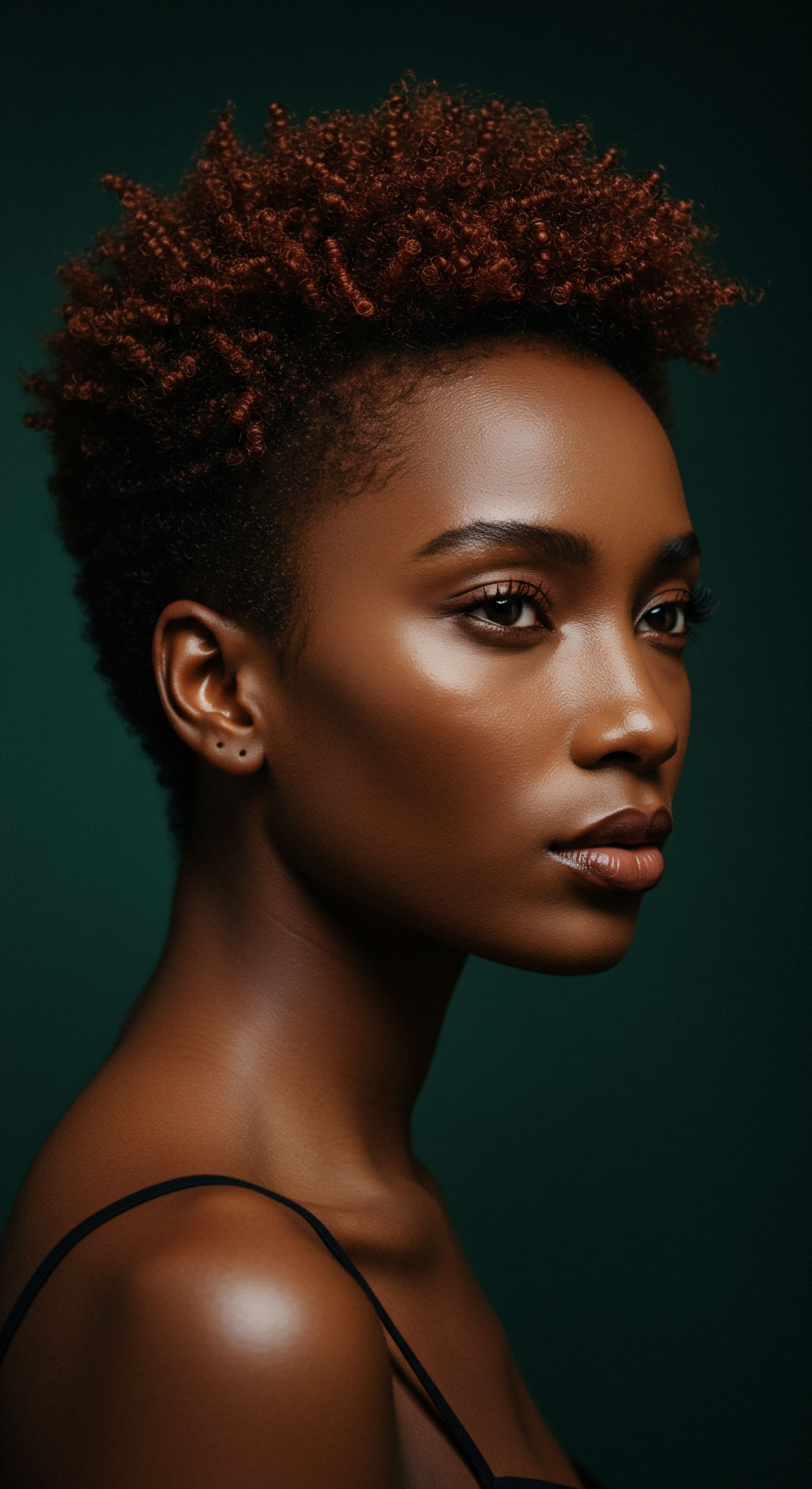The dance of pH within chemical hair treatments is a subtle yet profound one, shaping not only the immediate texture and appearance of our strands but also their long-term health and vitality. At Roothea, we approach this scientific interaction with the reverence it deserves, understanding that each shift on the pH scale carries a story for our hair, particularly for textured hair, which often possesses its own unique vulnerabilities and strengths. This exploration invites us to consider the underlying chemistry with a gentle curiosity, seeing it not as a rigid set of rules but as a delicate balance that, when understood, empowers us to care for our crowns with deeper wisdom.

Roots
The foundation of any hair transformation, whether it is a subtle shift or a dramatic change, lies within the very structure of the hair itself. To truly grasp the implications of chemical treatments, one must first appreciate the inherent nature of our strands, a complex arrangement of proteins and bonds, all living within a specific pH environment. Think of hair as a magnificent, living fiber, each strand a testament to intricate design, capable of immense resilience yet also susceptible to the forces that interact with it. Our journey into chemical treatments begins here, at the elemental level, understanding what makes hair, particularly textured hair, respond as it does.

The Hair’s Natural Acidity
Healthy hair and scalp naturally reside on the acidic side of the pH scale, typically ranging between 4.5 and 5.5. This slightly acidic state is no accident; it is a meticulously maintained biological environment. The hair’s outermost layer, the Cuticle, composed of overlapping scales like shingles on a roof, remains tightly closed and smooth in this acidic setting.
This tight closure is the hair’s primary defense, locking in moisture, reflecting light for a healthy sheen, and guarding the inner cortex from external aggressors. The scalp, too, shares a similar acidic mantle, around pH 5.5, which serves as a protective barrier against bacterial and fungal proliferation, helping to maintain its delicate ecosystem.
The hair’s inherent slightly acidic nature, typically between pH 4.5 and 5.5, is a protective embrace, sealing the cuticle and preserving moisture.

What is the Isoelectric Point of Hair?
Beyond the general acidic range, hair possesses a specific scientific marker known as the Isoelectric Point. This is the pH value at which the hair protein has an equivalent number of positive and negative charges, resulting in a net neutral charge. For human hair, this point is often cited around pH 3.67 or 3.7.
When hair products are formulated near or at this isoelectric point, they tend to cause less swelling of the hair fiber and can promote cuticle closure, contributing to a smoother feel. Deviations from this point, particularly towards alkalinity, can increase the negative electrical charge on the hair fiber surface, leading to greater friction between strands and potential cuticle damage.

The Delicate Balance of Hair Bonds
The very strength and shape of our hair, its curl pattern, and its resilience, are a result of complex chemical bonds within the keratin proteins. These include Disulfide Bonds, hydrogen bonds, and ionic bonds. Chemical treatments, by their very nature, interact with these bonds, temporarily or permanently altering them to achieve a desired texture or color. Understanding the pH at which these bonds are most stable, and conversely, most vulnerable, becomes paramount in minimizing potential harm during these transformative processes.
The hair proteins are in their most favorable condition and exhibit optimal thermal stability when maintained within their natural slightly acidic range. When the pH environment shifts significantly outside this range, the structural integrity of the hair can be compromised, leading to damage.

Ritual
The conscious application of chemical treatments to hair is a ritual, a deliberate act of transformation that has been practiced across cultures for centuries. Whether seeking to straighten, curl, or color, these processes engage with the hair’s intrinsic chemistry, prompting a profound shift in its structure. This section guides us through the practical application of pH in these treatments, unveiling how varying levels facilitate the desired changes and the subsequent care needed to restore harmony to the hair fiber. It is a dialogue between intention and chemistry, where understanding the pH becomes our compass.

The Alkaline Ascent Perms and Relaxers
Many common chemical hair treatments operate on the alkaline side of the pH scale, a necessary departure from the hair’s natural acidity. This alkaline environment is the key to opening the hair’s protective cuticle layer, allowing active ingredients to penetrate the inner cortex and reshape the hair’s disulfide bonds. Without this swelling and opening, the chemical agents could not reach their targets within the hair shaft. However, this intentional lifting of the cuticle also leaves the hair vulnerable, making the pH management during and after the treatment a delicate act of balance.
- Alkaline Perms ❉ Also known as “cold waves,” these perms do not require external heat for processing. They typically utilize ammonium thioglycolate as their primary ingredient and operate within a pH range of approximately 8.0 to 9.6, sometimes reaching 9.0 to 9.6. This alkalinity softens and swells the hair fibers, making it easier for the chemicals to enter the hair structure and reshape it.
- Acid Perms ❉ While termed “acid,” many modern acid-balanced perms are not truly acidic in the strictest sense, often having a pH between 6.5 and 8.5, or even 7.8 and 8.2. True acid waves, which historically required heat, can range from pH 4.5 to 7.0. They are generally gentler on the hair, causing minimal swelling, and are often recommended for hair that is damaged, porous, or previously treated.
- Chemical Relaxers ❉ These treatments aim to permanently straighten textured hair. They are among the most alkaline chemical treatments, with some hydroxide relaxers reaching pH levels as high as 12 to 14. Lye relaxers, which contain sodium hydroxide, typically range from pH 12 to 14, while no-lye relaxers may be slightly lower, around pH 9 to 11. The extreme alkalinity of these products is necessary to effectively break down the disulfide bonds within the hair, leading to a straightened form.

The Transformative PH of Color and Bleach
Coloring and lightening hair also rely on significant pH shifts to achieve their desired effects. The process of altering hair pigment requires careful manipulation of the hair’s outer and inner layers.
- Hair Color ❉ Permanent hair color typically operates within an alkaline pH range, often between 9 and 11. This alkalinity lifts the cuticle, allowing the color molecules to penetrate the cortex where they interact with the hair’s natural pigment. Temporary hair color may have a pH closer to neutral, around 7.0 to 8.0.
- Bleaching ❉ A more aggressive chemical process, bleaching aims to remove the natural pigment (melanin) from the hair. Bleaching solutions are highly alkaline, commonly ranging from pH 9 to 11. Hydrogen peroxide, a key component in bleaching, is generally acidic on its own (pH 3.5 to 5.0), but it is activated by an alkaline agent (like ammonia) in the bleach mixture, raising the overall pH to allow it to penetrate the hair fiber and oxidize melanin.
Chemical hair treatments intentionally shift the hair’s pH, predominantly towards alkalinity, to open the cuticle and enable structural changes, necessitating thoughtful post-treatment care.

What is the PH of Hair Neutralizers?
Following many alkaline chemical treatments, a crucial step involves the application of a Neutralizer. This product serves to halt the chemical process and, significantly, to bring the hair’s pH back down to a more acidic, healthy range. Neutralizers often contain acidic ingredients like hydrogen peroxide or sodium bromate.
Their pH can range broadly, from approximately 2.5 to 7.0, depending on the specific type and manufacturer. This acidic rebalancing helps to reseal the cuticle, reduce swelling, and restore the hair’s strength and integrity after the alkaline exposure.

Relay
The story of pH in hair treatments extends beyond mere chemical reactions; it is a relay of historical understanding, scientific advancement, and cultural expression. For textured hair, this conversation holds particular weight, as the historical context of chemical alteration often intersects with narratives of beauty standards and identity. This section delves into the deeper implications of pH, exploring the science of its impact on hair integrity, the subtleties of its interaction with diverse hair structures, and the ongoing dialogue between scientific innovation and the desire for hair wellness. It is a call to understand the profound interplay of these forces.

The Historical Trajectory of PH and Hair Alteration
The pursuit of altering hair texture through chemical means has a long and complex history, one that, while not always explicitly defined by pH measurements in earlier eras, inherently relied on the principles of acidity and alkalinity. Ancient civilizations utilized various natural substances to straighten or curl hair, many of which would have induced significant pH changes. The evolution of modern chemical relaxers and perms, particularly those designed for textured hair, reflects a journey from harsh, often damaging, high-alkaline formulations to more refined systems. Early lye-based relaxers, for instance, operated at extremely high pH levels, leading to considerable hair and scalp trauma.
The introduction of “no-lye” relaxers, while still alkaline, represented a step towards slightly less aggressive pH ranges, aiming to mitigate some of the damage, even if the underlying chemical principles remained similar. This historical progression highlights a gradual, albeit sometimes slow, recognition of pH as a central determinant of hair health during chemical processing.

How Do Extreme PH Levels Affect Hair Proteins?
The impact of pH on hair is fundamentally about its effect on keratin, the primary protein component of hair. When hair is exposed to extreme pH levels, whether highly acidic or highly alkaline, its protein structure can be significantly altered.
| PH Environment Highly Alkaline (pH > 8) |
| Hair Cuticle Response Cuticle scales swell and lift significantly, becoming more porous. |
| Protein Structure Response Protein bonds (especially salt links) can be disrupted; fiber swells; increased porosity. Leads to brittleness, dryness, frizz, breakage. |
| PH Environment Highly Acidic (pH < 4.5) |
| Hair Cuticle Response Cuticle can become too tight, potentially causing roughness or damage. |
| Protein Structure Response Hair can contract, becoming stiff and prone to breakage. Can strip natural oils, leading to split ends and accelerated color fading. |
| PH Environment Maintaining a balanced pH is paramount for hair integrity. |
A study exploring pH-induced changes in hair found that exposing hair to varying pH levels, particularly extreme acidic conditions (pH 3) and alkaline conditions (above pH 8), led to pronounced effects on both hair morphology and hair proteins. This research, utilizing proteomics analysis, identified alterations in the hair proteome, including significant deamidation of keratins, underscoring the critical role of pH in hair health. Haircare products with a pH between 5 and 7 had minimal impact on hair structure and proteins, suggesting this range is ideal for hair shaft health.
The precise pH of a chemical treatment is not a mere number; it is a determinant of hair’s vulnerability and resilience, deeply influencing its protein architecture.

What Role Does Hair Porosity Play in PH Responsiveness?
The natural porosity of hair, particularly relevant for textured hair types, significantly influences how strands respond to chemical treatments and their pH levels. Hair porosity refers to the hair’s ability to absorb and retain moisture, which is largely determined by the condition of its cuticle layer. High porosity hair, often characterized by raised or damaged cuticles, can absorb chemical solutions more quickly and intensely, potentially leading to over-processing and increased damage if not managed with precision. Conversely, low porosity hair, with its tightly bound cuticles, may resist initial penetration, requiring more alkaline solutions or longer processing times to achieve the desired effect.
This interplay means that a “one-size-fits-all” approach to chemical treatments, without considering the hair’s unique porosity, can yield unpredictable and often detrimental results. Stylists and individuals alike must consider porosity when selecting chemical treatment formulations and adjusting processing times, recognizing that the same pH level can elicit different responses across varying hair textures.

The PH of Post-Treatment Care ❉ A Return to Balance
The period immediately following a chemical treatment is critical for hair recovery. The hair, having been exposed to alkaline environments, is in a state of heightened porosity and vulnerability. This is where the wisdom of pH-balanced aftercare becomes indispensable. Products designed for post-treatment, such as neutralizing shampoos and conditioners, are formulated to gently guide the hair back to its natural acidic pH.
This acidic return helps to flatten the lifted cuticle scales, sealing them down and thereby locking in moisture, reducing frizz, and restoring the hair’s inherent protective barrier. Without this rebalancing, hair can remain rough, dry, dull, and susceptible to further damage and color fading. It underscores the principle that chemical transformation is a two-part process ❉ the alteration and the thoughtful restoration of balance.

Reflection
As we conclude our exploration into the pH of chemical hair treatments, a deeper understanding emerges ❉ the seemingly simple concept of acidity and alkalinity holds profound implications for the health and vibrancy of our hair, particularly for textured strands. This journey through the chemical landscapes of relaxers, perms, colors, and bleaches reveals that every intentional alteration of our hair’s structure is a dialogue with its innate chemistry. It is a conversation that demands respect, knowledge, and a gentle hand.
For those who choose to reshape their hair through these processes, knowing the pH ranges involved transforms the act from a mere cosmetic procedure into an informed ritual of care. It allows us to move beyond superficial concerns, recognizing that true hair wellness lies in understanding the intricate dance of bonds and balances, ensuring that each transformation is approached with wisdom, safeguarding the hair’s resilience for all its beautiful expressions.

References
- Gavazzoni Dias, M. F. R. (2015). The Shampoo pH can Affect the Hair ❉ Myth or Reality? International Journal of Trichology, 7(2), 95–96.
- K18 Pro. (n.d.). The truth behind hair pH .
- Design Essentials. (n.d.). Knowing Different Types of Hair Relaxers .
- Atlas Scientific. (2024, April 23). The Importance Of pH In Hair Products .
- Smiths Collective Brands. (2025, March 13). The Impact of pH on Hair Health and How to Restore Balance with Professional Haircare, Featuring REF .
- McTigue, A. (2023, October 12). What is Hair pH & Why it’s Important?. Allison McTigue Salon.
- Centre Clauderer. (n.d.). Hair PH ❉ Why is it important for hair health? .
- Kera Mane. (2024, October 28). Understanding the pH of Keratin Treatments ❉ How pH Levels Impact Your .
- Quizlet. (n.d.). Perming Flashcards .
- Quizlet. (2024, June 18). pH Levels for Perms and Relaxers Study Guide .
- Dutch Health Store. (2024, July 9). pH of hair ❉ What is it and why does it matter? .
- Loria, M. (1994). Hair relaxer and post-relaxer hair brightener system. U.S. Patent 5,293,885.
- NAR LONDON. (2020, December 29). UNDERSTANDING HAIR & HAIR LOSS .
- Britannica. (n.d.). The Science Behind Hair Bleaching .
- DiStefano Hair Restoration Center. (2022, February 24). What’s the Right pH Level for Your Hair? .
- Quora. (2019, February 13). Can I use hydrogen peroxide or conditioner as a bleach activator? I’m trying to lighten my hair with as little damage as possible .
- ThePermDude. (2018, May 20). Perms 101- Acid wave. YouTube.
- K18. (2024, November 3). everything you need to know about pH + hair .
- Groll, A. (2002). Method and composition adjusted to the isoelectric point of hair for conditioning of oxidatively dyed hair. U.S. Patent Application Publication US2002/0122783 A1.
- Prezi. (n.d.). The difference between an alkaline wave and acid wave .
- Anton Paar Wiki. (n.d.). Surface charge of hair .
- Stay Current Florida. (n.d.). RELAXER THEORY .
- Gillespie, J. M. (1983). Characterization of the proteins of human hair and nail by electrophoresis. Journal of Investigative Dermatology, 80(5), 375-378.
- Hairy Truths. (n.d.). pH – The Power of Hydrogen; So why should we care? .
- Perms and Hair. (n.d.). Do alkaline perms need heat .
- Hairfinder. (n.d.). The difference between acid waves and alkaline perms .
- Nebeau. (n.d.). Why Hydrogen Peroxide is added to hair colour .
- Hairfinder. (n.d.). Permanent waves, perms and the formulations for different hair types .
- Redken Report. (n.d.). Here’s Why Acidic Hair Color Is a Must-Have .
- Diffen. (2011, February 22). Difference Between Alkaline and Acid Perm .
- Worldofbraiding Blog. (2011, May 7). HOW CHEMICAL RELAXERS AFFECT YOUR HAIR .
- Brainly. (2023, October 24). What is the pH range of an acid balance permanent wave solution? .
- Patel, A. R. (1988). Neutralizer for permanently waving hair. U.S. Patent 4,770,872.
- Goldwell. (n.d.). PH Value .
- Brainly. (2023, December 28). What is the pH level of hydrogen peroxide, a commonly used developer in hair color products? .
- René Furterer. (n.d.). What are the different techniques for lightening hair? .
- Patel, A. R. (1988). Neutralizer for permanently waving hair. U.S. Patent 4,770,872.
- Naturally Drenched. (2023, August 30). Why is pH important for color treated hair? .
- Brainly. (2023, December 5). Sodium hydroxide relaxers have an alkaline pH of ❉ A. 1-3 B. 4-6 C. 7-8 D. 10-14 .
- Worldofbraiding Blog. (2011, May 7). HOW CHEMICAL RELAXERS AFFECT YOUR HAIR .
- Hair Gain Now. (2023, August 24). What Is The pH Of Your Hair And Scalp And Why Is It So Important? .
- Lante, C. D’Angelo, F. Naccarato, A. & Censi, R. (2024). Insights into structural and proteomic alterations related to pH-induced changes and protein deamidation in hair. Journal of Cosmetic Dermatology, 23(1), 324-332.
- K18 Australia. (2022, August 16). How Do pH Levels in Hair Care Products Affect Your Hair .
- Quora. (2019, August 2). How long does it take for hydrogen peroxide to lighten hair? .